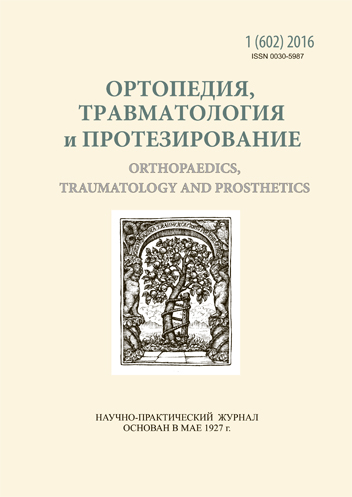The nature and structure of pelvic area damage in patients with polytrauma andunstable pelvic ring
DOI:
https://doi.org/10.15674/0030-5987201615-9Keywords:
structure, polytrauma, pelvic area, instability of the pelvic ringAbstract
The goal: to investigate the nature and structure of the pelvic area injury (PAI) in casualties with severe concomitant injury and unstable pelvic ring.
The methods: the medical records of 406 casualties (157 survivors, 249 dead) with an unstable pelvis injury in polytrauma were analyzed. The severity of the injury was assessed according to the integral scales ISS, PTS, ATS. The conclusion forensic examinations were studied for the dead.
Results: among different types of injury traffic accident (245; 60.3 %) and household injuries (136; 33.5 %) were predominated, from point of view of injury genesis — catatrauma (150; 36.9 %). Unstable pelvic injuries in polytrauma were diagnosed more than half of patients with PAI with a predominance of rotationally unstable fractures (type B) — 307 (75.6 %). Vertically unstable lesions (type C) were observed in 99 (24.4 %) cases. Concomitant acetabular fractures were observed in 11.8 % of patients, damage to the pelvic organs (PO) — in 24.1%. Among PO following ruptures were detected: bladder — 48 (11.8 %), urethra — 27 (6.7 %), rectum — 5 (1.2 %),uterus and ovarian — 3 (0.7 %), great vessels — 5 (1.2 %), several PO — 10 (2.5 %). The severity of the damage of the different anatomical regions (AR) according to the scales ISS, PTS, ATS in group of survivors and deaths did not differ significantly (p > 0.05),but from the point of view of general severity of injury the differences between the groups were significant (p < 0.05). Lethal outcome was recorded in 249 cases (61.3 %). The greatest number of casualties died at 1–3 days post-injury — 185 cases (74.3 %); 4–10-days — 42 cases (16.9 %), 10 days after trauma and more — 22 cases (8.8%). In 72 28.9 %) cases, the results of forensic medical examination did not match the final diagnosis of damage severity of pelvic ring injury.
Conclusions: unstable pelvic injury (type B and C) in patients with polytrauma was identified in 51.9 %of cases, while rotationally unstable fractures (type B) — 2/3. Vertically unstable fracture (type C) increases the risk of death by almost two times. Crucial to survival prognosis in polytrauma has a number of damaged AR due to the development of mutual burdening syndrome.
References
- Bokarev IM. Lechebno-diagnosticheskaya taktika u patsientov s sochetannoy travmoy zhivota i taza: abstract dis. the doctor of medical scince. 2006. 32 p.
- Zarutskiy YaL, Denisenko VM, Zhovtonozhko OI, Burluka VV, et al. Sposib anatomichnoyi otsinki politravm. Patent 61359 UA. 2011.
- Rzaev RS. Lechenie povrezhdeniy taza s narusheniem tselostnosti ego koltsa u postradavshih s shokogennoy travmoy: abstract dis. the candidate of medical scince. SPb. 2010. 22 p.
- Sotnikova IS. Obosnovanie taktiki hirurgicheskogo lecheniya povrezhdeniy pryamoy kishki pri sochtennoy travme: abstract dis. the candidate of medical scince. Rostov-na-Donu, 2004. 158 p.
- Tyimchenko SA. Osobennosti sovremennoy boevoy patologii uretryi: abstract dis. the candidate of medical scince. M., 2008.19 p.
- Grimme K, Pape H, Probst C, et al. Calculation of different triage scores based on the German Trauma Registry. Eur J Trauma. 2005;31:480–487.
- Morozumi J, Homma H, Ohta S, Noda M, Oda J, Mishima S, Yukioka T. Impact of mobile angiography in the emergency department for controlling pelvic fracture hemorrhage with hemodynamic instability. J Trauma. 2010;68(1):90–95. doi: 10.1097/TA.0b013e3181c40061.
- Hauschild O, Strohm PC, Culemann U, Pohlemann T, Suedkamp NP, Koestler W, Schmal H. Mortality in patients with pelvic fractures: results from the German pelvic injury register. J Trauma. 2008;64(2):449–455. doi: 10.1097/TA.0b013e31815982b1.
- Pape HC, Krettek C. Management of fractures in the severely injured influence of the principle of «damage control orthopaedic surgery». Unfallchirurg. 2003;106(2):18–24.
- Demetriades D, Karaiskakis M, Toutouzas K, Alo K, Velmahos G, Chan L. Pelvic fractures: epidemiology and predictors of associated abdominal injuries and outcomes. J Am. Coll. Surg. 2002;195 (1):1–10.
- Smith WR, Ziran BH, Morgan SJ. Fractures of the pelvis and acetabulum. NY: Inform. Healthcare, 2007. 371 p.
- Sturmer KM, Neugebauer E. Guideline on treatment of patients with severe and multiple injuries. Germany, 2011. 421 p.
- Baker SP, O’Neill B, Haddon W, et al. The Injury Severity Score: a method of describing patients with multiple injuries and evaluatiting emergency care. J Trauma. 1974;14:187–196.
- Tile M. Fractures of the pelvis and acetabulum. Williams & Wil-kins, 1995. 480 p.
- Yerasimides J, Roberts CS. Pelvic fractures and genitourinary injuries. Curr. orthopaed. 2005;19:354–361.
Downloads
How to Cite
Issue
Section
License
Copyright (c) 2016 Nicolay Аnkin, Lev Аnkin, Vladimir Burluka, Andrey Tkachenko, Vladimir Salamashchak

This work is licensed under a Creative Commons Attribution 4.0 International License.
The authors retain the right of authorship of their manuscript and pass the journal the right of the first publication of this article, which automatically become available from the date of publication under the terms of Creative Commons Attribution License, which allows others to freely distribute the published manuscript with mandatory linking to authors of the original research and the first publication of this one in this journal.
Authors have the right to enter into a separate supplemental agreement on the additional non-exclusive distribution of manuscript in the form in which it was published by the journal (i.e. to put work in electronic storage of an institution or publish as a part of the book) while maintaining the reference to the first publication of the manuscript in this journal.
The editorial policy of the journal allows authors and encourages manuscript accommodation online (i.e. in storage of an institution or on the personal websites) as before submission of the manuscript to the editorial office, and during its editorial processing because it contributes to productive scientific discussion and positively affects the efficiency and dynamics of the published manuscript citation (see The Effect of Open Access).














